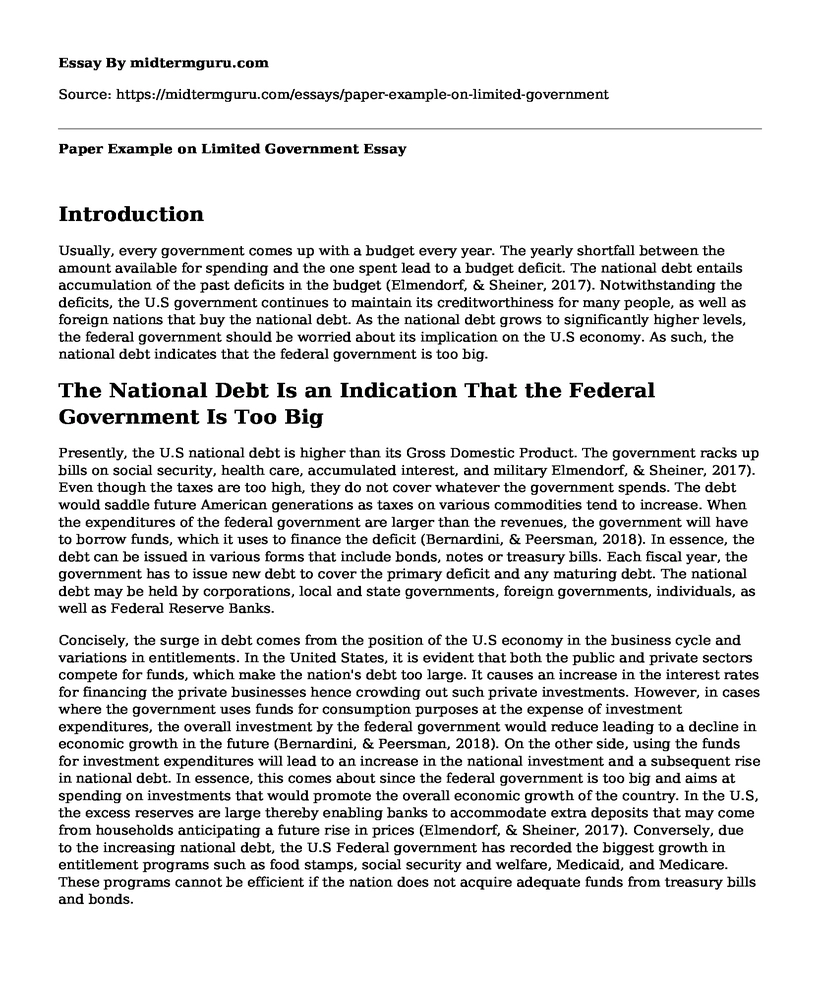Introduction
Usually, every government comes up with a budget every year. The yearly shortfall between the amount available for spending and the one spent lead to a budget deficit. The national debt entails accumulation of the past deficits in the budget (Elmendorf, & Sheiner, 2017). Notwithstanding the deficits, the U.S government continues to maintain its creditworthiness for many people, as well as foreign nations that buy the national debt. As the national debt grows to significantly higher levels, the federal government should be worried about its implication on the U.S economy. As such, the national debt indicates that the federal government is too big.
The National Debt Is an Indication That the Federal Government Is Too Big
Presently, the U.S national debt is higher than its Gross Domestic Product. The government racks up bills on social security, health care, accumulated interest, and military Elmendorf, & Sheiner, 2017). Even though the taxes are too high, they do not cover whatever the government spends. The debt would saddle future American generations as taxes on various commodities tend to increase. When the expenditures of the federal government are larger than the revenues, the government will have to borrow funds, which it uses to finance the deficit (Bernardini, & Peersman, 2018). In essence, the debt can be issued in various forms that include bonds, notes or treasury bills. Each fiscal year, the government has to issue new debt to cover the primary deficit and any maturing debt. The national debt may be held by corporations, local and state governments, foreign governments, individuals, as well as Federal Reserve Banks.
Concisely, the surge in debt comes from the position of the U.S economy in the business cycle and variations in entitlements. In the United States, it is evident that both the public and private sectors compete for funds, which make the nation's debt too large. It causes an increase in the interest rates for financing the private businesses hence crowding out such private investments. However, in cases where the government uses funds for consumption purposes at the expense of investment expenditures, the overall investment by the federal government would reduce leading to a decline in economic growth in the future (Bernardini, & Peersman, 2018). On the other side, using the funds for investment expenditures will lead to an increase in the national investment and a subsequent rise in national debt. In essence, this comes about since the federal government is too big and aims at spending on investments that would promote the overall economic growth of the country. In the U.S, the excess reserves are large thereby enabling banks to accommodate extra deposits that may come from households anticipating a future rise in prices (Elmendorf, & Sheiner, 2017). Conversely, due to the increasing national debt, the U.S Federal government has recorded the biggest growth in entitlement programs such as food stamps, social security and welfare, Medicaid, and Medicare. These programs cannot be efficient if the nation does not acquire adequate funds from treasury bills and bonds.
Conclusion
Precisely, when a government is large enough, it can protect its citizens and their property. However, it should not be too large to threaten those governed by imposing high taxes on essential commodities. In essence, when the overall national spending is more than what the nation takes in, it shows that the country has reached beyond what it is capable of governing effectively. Therefore, it would show an accrual of national debt as the government needs to spend on different programs. The national debt indicates that the federal government is too large hence might threaten the lives of its citizens through high taxes on various products. The problem of financing current consumption is troubling for the Americans as the government fails to finance investment.
References
Bernardini, M., & Peersman, G. (2018). Private debt overhang and the government spending multiplier: Evidence for the United States. Journal of Applied Econometrics, 33(4), 485-508.
Elmendorf, D. W., & Sheiner, L. M. (2017). Federal budget policy with an aging population and persistently low interest rates. Journal of Economic Perspectives, 31(3), 175-94.
Cite this page
Paper Example on Limited Government. (2022, Sep 26). Retrieved from https://midtermguru.com/essays/paper-example-on-limited-government
If you are the original author of this essay and no longer wish to have it published on the midtermguru.com website, please click below to request its removal:
- The Nature of Social Policy and the Welfare States and Theories - Essay Sample
- Essay on Public Involvement in Community Planning
- Argumentative Essay on Teenage Driving
- Essay Sample on International Relation Theories
- The Danger of Progress: Bradbury's Pedestrian - Essay Sample
- US and Iraq: A Conflict of Lack of Trust - Essay Sample
- Albert Einstein: Economics Research & Discoveries on Socialism - Essay Sample







